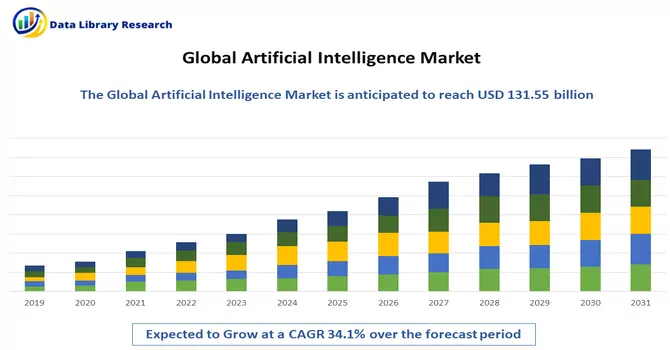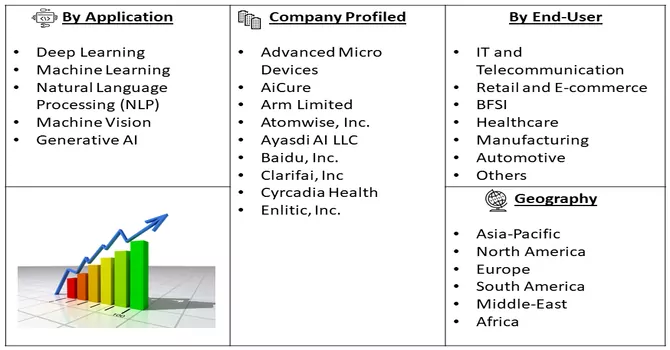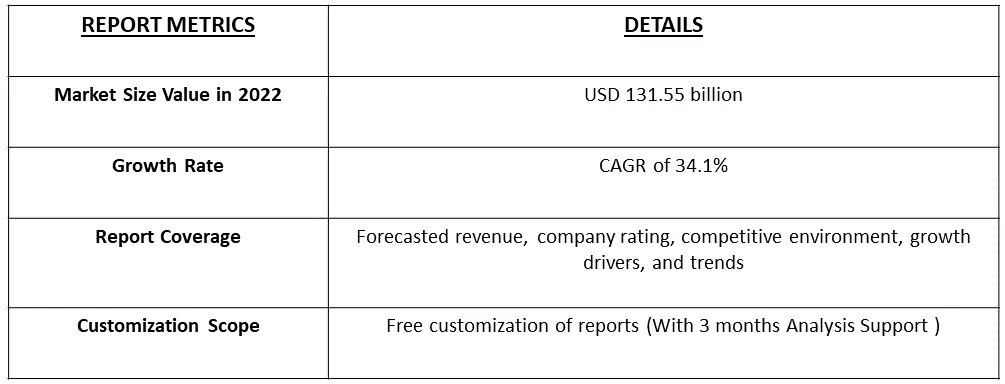The global artificial intelligence market size was valued at USD 131.55 billion in 2022 and is projected to expand at a compound annual growth rate (CAGR) of 34.1% from 2023 to 2030.

Get Complete Analysis Of The Report - Download Free Sample PDF
Artificial Intelligence (AI) refers to the simulation of human intelligence in machines, primarily through the development of computer programs and algorithms. AI systems are designed to perform tasks that typically require human intelligence, such as problem-solving, learning, reasoning, understanding natural language, and adapting to new information. These systems can analyze data, make decisions, and automate processes, often with the goal of achieving specific objectives or solving complex problems. AI encompasses a wide range of technologies and applications, including machine learning, natural language processing, computer vision, and robotics, among others. It is a rapidly evolving field with the potential to revolutionize various industries and enhance human capabilities.
The continuous research and innovation directed by tech giants are driving the adoption of advanced technologies in industry verticals, such as automotive, healthcare, retail, finance, and manufacturing is expected to drive the growth of the studied market.
The AI market was experiencing significant growth, and this trend was expected to continue. AI was being adopted across various industries, including healthcare, finance, retail, and manufacturing. Businesses were increasingly using AI to automate tasks and processes. This trend was driven by the need for efficiency and cost reduction. Moreover, AI applications in healthcare were expanding, with the use of AI for medical diagnosis, drug discovery, and patient management. The COVID-19 pandemic also accelerated the adoption of AI in healthcare.

For Detailed Market Segmentation - Download Free Sample PDF
Market Drivers :
Economical Parallel Processing Set-Up and Potential R&D In Artificial Intelligence Systems
Parallel processing has been a cornerstone of the advancements in Artificial Intelligence (AI) systems, enabling the training and execution of complex AI models at unprecedented speeds. To maintain the growth and innovation in the AI field while managing costs, the development of economical parallel processing setups and targeted research and development (R&D) efforts is crucial. One of the most effective ways to create an economical parallel processing setup is to leverage distributed computing. Instead of relying on a single high-end server, distributing the workload across multiple less expensive machines can significantly reduce costs. Technologies like Kubernetes and Docker have made this process more accessible. Thus, creating economical parallel processing set-ups and focusing R&D efforts on efficiency and emerging AI technologies will play a pivotal role in the continued growth of the artificial intelligence market. As AI becomes more pervasive across industries, it is essential to strike a balance between technological innovation and cost-effectiveness to maximize its potential benefits.
Big Data Fueling AI And Machine Learning Profoundly and Increasing Cross-Industry Partnerships And Collaborations
The synergy between Big Data and Artificial Intelligence (AI) has had a profound impact on the capabilities of machine learning and AI systems. Big Data provides an abundance of structured and unstructured data, which is invaluable for training and fine-tuning machine learning models. This wealth of data enables AI systems to learn and adapt more effectively. With access to extensive datasets, AI and machine learning models can make more accurate predictions, identify trends, and uncover hidden patterns in data. This is particularly beneficial in applications like predictive maintenance, fraud detection, and recommendation systems. Thus, the combination of Big Data, cross-industry collaborations, and the growing adoption of AI across various sectors continues to shape the artificial intelligence market. The landscape is evolving rapidly, and businesses and researchers are exploring new ways to harness the potential of AI to solve complex problems and deliver innovative solutions.
Market Restraints. :
Vast Demonstrative Data Requirement
Acquiring the necessary data, especially for niche or specialized applications, can be challenging. Not all industries have readily available, high-quality data, and collecting such data can be a resource-intensive and time-consuming process. Moreover, storing and processing vast amounts of data necessitates substantial computational resources, which can be costly and require ongoing maintenance. Thus, these factors are expected to slow down the growth of the studied market.
The COVID-19 pandemic has had profound and multifaceted effects on the world, including the field of artificial intelligence (AI). The AI industry has experienced both challenges and opportunities as it adapts to the changing global landscape. COVID-19 accelerated the digital transformation of businesses and organizations. Remote work, online education, telehealth, and e-commerce saw increased demand. AI technologies, such as virtual assistants, chatbots, and recommendation systems, played a vital role in enhancing digital experiences. Thus, the pandemic reshaped how organizations view AI. Many businesses recognize the importance of AI in ensuring resilience and adaptability. This could lead to sustained growth in AI adoption in the post-pandemic world.
Segmental Analysis:
Software Segment is Expected to Slow down the Growth of the Studied Market Over the Forecast Period
Software and artificial intelligence (AI) are two interconnected domains that have a profound impact on various industries, from healthcare and finance to manufacturing and entertainment. The synergy between software and AI has led to significant advancements in the development of intelligent applications and systems, changing the way we live and work. AI, through software interfaces, automates tasks and optimizes processes across industries. From supply chain management to healthcare operations, AI-driven software solutions enhance efficiency and productivity. Thus, the integration of software and artificial intelligence has ushered in a new era of innovation, transforming the way we interact with technology and the world around us. These synergistic technologies continue to revolutionize industries, creating more efficient and intelligent solutions that address complex challenges. As AI and software development continue to evolve, we can expect even more groundbreaking applications that will shape the future of human-computer interaction and drive further advancements across multiple domains.
Deep Learning Segment is Expected to Slow down the Growth of the Studied Market Over the Forecast Period
Deep learning is a subset of artificial intelligence (AI) that has garnered significant attention and transformed the AI landscape. Deep learning involves training artificial neural networks with multiple layers to learn and make sense of complex patterns and data. Deep learning has revolutionized computer vision with applications like image recognition, object detection, and facial recognition. These technologies power autonomous vehicles, security systems, and medical imaging analysis. Deep learning has played a pivotal role in advancing NLP. It's behind chatbots, language translation, sentiment analysis, and voice assistants, making human-computer interactions more natural and effective. Thus, owing to such advances the segment is expected to witness significant growth over the forecast period.
North American region is Expected to Slow down the Growth of the Studied Market Over the Forecast Period
North America, particularly the United States and Canada, plays a central role in the global landscape of artificial intelligence (AI). The region is home to a rich ecosystem of AI research, development, and application, driving innovation and shaping the AI industry.
North American healthcare institutions are at the forefront of applying AI for medical imaging, drug discovery, and patient care. Companies like IBM Watson Health are working on innovative healthcare AI solutions.
Furthermore, the presence of major North American companies, such as Waymo, General Motors, and Tesla, are pioneering the development of autonomous vehicles, pushing the boundaries of AI in transportation in the region, which is expected the drive the studied market growth in the region. For instance, in April 2023, H20.ai announced a strategic partnership with GeoTechnologies, a Japan-based provider of map data & and location information solutions for vehicle navigation systems. The company has leveraged H20.ai’s H2O AI Cloud to develop an AI-powered platform that uses onboard camera footage for gauging sidewalk safety. Similarly, In July 2022, Clarifai announced the launch of its ‘Clarifai Community’ free service for enabling everyone to share, create, and use The World’s AI. Moreover, it also announced the development of the ‘AI Lake’ product category, which collects and centralizes every AI resource of an enterprise and offers tools for sharing across the enterprise. Thus, due to the above-mentioned reasons the market is expected to witness significant growth over the forecast period.

Get Complete Analysis Of The Report - Download Free Sample PDF
Some prominent players in the global artificial intelligence market include:
Recent Development:
1. In June 2023, AMD unveiled its AI Platform strategy with the introduction of the AMD Instinct MI300 Series accelerator family, which included a first look at the AMD Instinct MI300X accelerator. The accelerator has been developed for the purpose of large language model training and inference for generative AI workloads.
2. In September 2022, AiCure launched its clinical site services program that partners with sponsors and sites through the course of research and offers data-driven, actionable insights to minimize study risks and optimize workflow.
Q1. How big is the Artificial Intelligence Market?
The global artificial intelligence market size was valued at USD 131.55 billion in 2022 and is projected to expand at a compound annual growth rate (CAGR) of 34.1%.
Q2. At what CAGR is the market projected to grow within the forecast period?
Artificial Intelligence Market is projected to expand at a compound annual growth rate (CAGR) of 34.1% over the forecast period.
Q3. Which region has the largest share of the Artificial Intelligence Market? What are the largest region's market size and growth rate?
North America has the largest share of the market. For detailed insights on the largest region's market size and growth rate request a sample here
Q4. Who are the key players in Artificial Intelligence Market?
Some key players operating in the market include:
Data Library Research are conducted by industry experts who offer insight on industry structure, market segmentations technology assessment and competitive landscape (CL), and penetration, as well as on emerging trends. Their analysis is based on primary interviews (~ 80%) and secondary research (~ 20%) as well as years of professional expertise in their respective industries. Adding to this, by analysing historical trends and current market positions, our analysts predict where the market will be headed for the next five years. Furthermore, the varying trends of segment & categories geographically presented are also studied and the estimated based on the primary & secondary research.
In this particular report from the supply side Data Library Research has conducted primary surveys (interviews) with the key level executives (VP, CEO’s, Marketing Director, Business Development Manager and SOFT) of the companies that active & prominent as well as the midsized organization
FIGURE 1: DLR RESEARH PROCESS

Extensive primary research was conducted to gain a deeper insight of the market and industry performance. The analysis is based on both primary and secondary research as well as years of professional expertise in the respective industries.
In addition to analysing current and historical trends, our analysts predict where the market is headed over the next five years.
It varies by segment for these categories geographically presented in the list of market tables. Speaking about this particular report we have conducted primary surveys (interviews) with the key level executives (VP, CEO’s, Marketing Director, Business Development Manager and many more) of the major players active in the market.
Secondary ResearchSecondary research was mainly used to collect and identify information useful for the extensive, technical, market-oriented, and Friend’s study of the Global Extra Neutral Alcohol. It was also used to obtain key information about major players, market classification and segmentation according to the industry trends, geographical markets, and developments related to the market and technology perspectives. For this study, analysts have gathered information from various credible sources, such as annual reports, sec filings, journals, white papers, SOFT presentations, and company web sites.
Market Size EstimationBoth, top-down and bottom-up approaches were used to estimate and validate the size of the Global market and to estimate the size of various other dependent submarkets in the overall Extra Neutral Alcohol. The key players in the market were identified through secondary research and their market contributions in the respective geographies were determined through primary and secondary research.
Forecast Model
